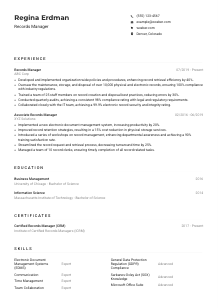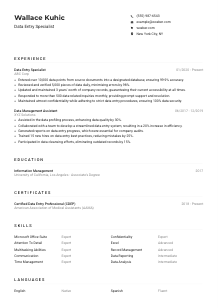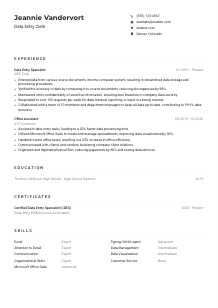Data Processor Resume Example
Juggling datasets, but your resume feels misplaced? Process the possibilities with this Data Processor resume example, structured using Wozber free resume builder. See how you can align your data-defining skills with job specifics, and chart your career's most efficient routes to success!

How to write a Data Processor resume?
Embarking on the Data Processor career path? It's crucial to have a resume that doesn't just blend in but stands out, echoing your expertise and the niche skills this role demands. We've got you covered with tailored guidance, leveraging the power of Wozber's free resume builder.
This guide will lead you through crafting a resume that not only visualizes your capabilities but also is fine-tuned for the job you're aiming for. Embrace the journey of transforming your resume into a compelling narrative that opens doors to your dream Data Processor role!
Personal Details
The 'Personal Details' section is your first handshake with potential employers - it's where you make your initial impression. Let's break down how to ensure your contact information aligns perfectly with the Data Processor position and strikes the right chord from the get-go.
1. Boldly Brand Your Name
Your name is your professional headline, your personal brand. Ensure it commands attention, setting a professional tone with a clear, readable font. Think of it as the title of your professional story.
2. Position Title Precision
Directly below your name, affirm your career identity by aligning with the targeted job title. For instance, labeling yourself as a 'Data Processor' right away aligns your professional identity with the role at hand, creating a seamless fit in the mind of the recruiter.
3. Essential Contact Info
Include your most reliable contact number and a professional email address, ideally in the firstname.lastname@domain.com format. Double-check for accuracy to ensure the recruiter can reach you without a hitch.
4. Location, Location, Location
"Los Angeles, California" isn't just where you're located; it's a strategic piece of information that aligns with the job's geographical requirements, assuring the employer of your availability and fit.
5. Digital Presence
A LinkedIn profile or a professional website can offer a deeper insight into your professional journey. Ensure these profiles are current and mirror the professionalism of your resume.
Takeaway
Think of the 'Personal Details' section as the opening act of your professional introduction. Keep it neat, precise, and reflective of the key details that align you with the targeted Data Processor role. Perfecting this section sets a professional tone for the rest of your resume.





Experience
The 'Experience' section is where your resume gets down to the nuts and bolts of why you're the perfect fit for the Data Processor role. It's all about showcasing how your past roles have prepared you for this exact position. Let's dive into transforming your experiences into compelling narratives.
- Processed, sanitized, and analyzed over 10,000 data entries, maintaining an accuracy rate of 99.9%.
- Verified and ensured a 100% completeness rate of all processed data, reducing potential discrepancies by 40%.
- Expertly utilized Microsoft Excel and SQL database tools to streamline data management, improving overall efficiency by 30%.
- Identified and resolved complex data errors, enhancing data integrity and security by 35%.
- Effectively communicated data insights to a team of 15 stakeholders, leading to a 25% faster decision‑making process.
- Assisted senior analysts in processing and organizing daily data inputs, averaging 500 entries per day.
- Conducted routine data quality checks, reducing errors by 20% over a six‑month period.
- Contributed to the development of an automated data entry system, decreasing manual data entry time by 50%.
- Collaborated with IT team to troubleshoot and resolve data management software issues, achieving an 85% issue resolution rate.
- Generated reports based on data analysis findings, providing valuable insights to the marketing department.
1. Aligning with Job Requirements
Scrutinize the job description, highlighting keywords and phrases like 'data sanitization', 'data analysis', and 'SQL database tools'. These are your cues for tailoring your experience to speak directly to what the employer is seeking.
2. Structure Wisely
List your positions in reverse chronological order, focusing on roles and responsibilities that resonate with the Data Processor job. Make it easy for recruiters to see the trajectory of your career leading up to this point.
3. Craft Accomplishment Statements
Transform responsibilities into achievements. For example, "Processed and analyzed over 10,000 data entries, maintaining an accuracy rate of 99.9%" speaks volumes about your attention to detail and proficiency.
4. Quantifiable Success
Quantify your accomplishments wherever possible. Numbers provide a concrete measure of your impact and effectiveness, making your achievements more tangible and relatable for recruiters.
5. Relevance is Key
While it's tempting to list all your career highlights, focus on the ones that resonate most with the Data Processor role. This ensures your resume is not cluttered with irrelevant information, making the relevant skills and achievements shine.
Takeaway
The 'Experience' section of your resume is a powerful tool to illustrate your readiness and fit for the Data Processor role. Tailor your accomplishments to reflect the job description, using quantifiable metrics to highlight your successes. Show them you're not just a fit, but the perfect candidate for the position.
Education
The 'Education' section is more than just a formality; it's a reflection of the groundwork that's prepared you for the Data Processor role. Let's curate your educational background in a way that highlights its relevance and alignment with the job specifications.
1. Highlight the Required Degree
Explicitly mention your Bachelor's degree in Computer Science, aligning perfectly with the job's educational requirement. This direct correlation emphasizes your qualification for the role from an academic standpoint.
2. Simplicity and Clarity
Maintain clarity with the structure: Degree, Field of Study, University Name, and Graduation Date. This straightforward format makes it easy for recruiters to verify your academic credentials against their criteria.
3. Degree Specificity
"Bachelor of Science in Computer Science" resonates directly with the job's requirements, proving you have the exact educational background the employer is seeking.
4. Coursework Relevance
If applicable, highlighting particular courses relevant to data processing and management can further demonstrate the depth of your knowledge and preparedness for the role.
5. Showcase Achievements
Academic honors or participation in relevant projects or clubs can be a plus, especially if they're directly related to data processing or computer science, showcasing your commitment and enthusiasm in your field.
Takeaway
Your educational background sets the foundation of your qualification for the Data Processor role. By aligning your education section closely with the job requirements, you reinforce your suitability and readiness to tackle the challenges of the position.
Certificates
Certificates are your arsenal to showcase continued learning and specialization. Even when not explicitly required, they can significantly bolster your candidacy for the Data Processor position. Let's navigate through positioning your certifications to highlight your dedication and expertise.
1. Job Specification Alignment
Identify any certifications that directly correlate with the job's demands, such as 'Certified Data Processor'. These directly relevant credentials catch the recruiter's eye and affirm your specialization.
2. Quality over Quantity
List certifications that showcase depth in data processing and analysis. Your goal is to demonstrate a commitment to the profession, highlighting qualifications that elevate your expertise above the candidate pool.
3. Validity and Recency
Include the acquisition or expiration dates for your certifications to portray them as current. This demonstrates your ongoing commitment to professional development, a highly valued trait.
4. Keep Evolving
Stay abreast of emerging tools and techniques in data processing. Pursuing and updating your certifications not only enriches your skill set but showcases a dedication to your career growth.
Takeaway
Though certifications may not always be a prerequisite, they are potent indicators of your commitment to ongoing learning and professional improvement. For the Data Processor role, they underscore your expertise and set you apart in a competitive field. Embrace them as tools for advancement and markers of your professional dedication.
Skills
In the realm of data processing, your skillset is the toolkit you bring to the table. The 'Skills' section is a concise showcase of your professional capabilities, meticulously aligned with the needs of the role. Let's refine this section to resonate with the proficiency and depth required for a Data Processor.
1. Match Job Description Keywords
Identify and list skills directly from the job description such as 'Microsoft Excel', 'SQL', and 'data analysis'. This direct correlation signals to ATS and recruiters alike that your skillset is tailored for the Data Processor role.
2. Balance Hard and Soft Skills
Combine technical proficiencies with interpersonal skills like 'effective communication' and 'team collaboration'. This portrays you as a well-rounded candidate capable of thriving in cross-functional teams.
3. Organized Presentation
Prioritize skills in order of relevance and proficiency. For a Data Processor, analytical skills and software tools knowledge should be at the forefront, presented in a clear, easy-to-scan format.
Takeaway
The 'Skills' section is your opportunity to impress upon the hiring manager that you're not just a good fit for the Data Processor position; you're the perfect fit. By thoughtfully aligning your skills with the job requirements, you position yourself as a prime candidate endowed with the exact suite of capabilities the role demands.
Languages
Given the global nature of data processing, your linguistic capabilities can add a unique value to your profile. Even if not explicitly required for the role, language skills can enhance your appeal, especially in organizations with diverse teams or international clients. Let's navigate through tailoring this section in the context of a Data Processor resume.
1. Comprehend the Requirements
Start by noting the specific language requirements mentioned in the job description. For our Data Processor example, proficiency in "English for business communication" is a must.
2. Prioritize Important Languages
Place the languages critical to the job, such as English, at the top of your list, highlighting your proficiency level clearly.
3. Additional Languages
If you speak more languages, list them to showcase your versatility and potential to collaborate with international teams or handle global datasets.
4. Be Transparent About Proficiency
Clearly state your language proficiency levels to set accurate expectations. Use terms like 'native', 'fluent', 'intermediate', and 'basic' to describe your comfort and skill levels succinctly.
5. Role Scope and Language Skills
Understand the broader implications of the role. If the Data Processor position involves working on projects with a global outreach, additional languages can significantly strengthen your application.
Takeaway
Your linguistic prowess is a testament to your capacity for cross-cultural collaboration and adaptability. For a Data Processor, these skills can open doors to international projects and collaborations, setting you apart. Highlight your languages with precision and pride, showcasing them as the unique assets they are in the global marketplace.
Summary
The 'Summary' section is your resume's elevator pitch - a succinct encapsulation of your professional identity, tailored to the Data Processor role. It's your chance to communicate your value and potential impact right from the start. Let's craft a summary that leaves no doubts about your fit for the role.
1. Decode the Role
Begin with a deep understanding of the job and its requirements. Reflecting on the role of a Data Processor, it's clear that skills in 'data analysis', 'Microsoft Excel', and 'SQL' are crucial.
2. Start Strong
Open with a powerful statement that encapsulates your experience and aligns with the role. For example, mentioning your years of experience in data processing sets a strong, relevant tone.
3. Highlight Relevant Skills and Achievements
List your core skills and prime accomplishments that directly reflect the job's demands. This not only shows your suitability but also your potential impact in the role.
4. Brevity is Key
Keep your summary focused and concise. Aim for 3-5 impactful lines that draw the recruiter in, compelling them to explore the rest of your resume in depth.
Takeaway
The 'Summary' section is your chance to immediately communicate your readiness and enthusiasm for the Data Processor position. By distilling your professional essence into a few powerful lines, you set the stage for a resume that resonates with precision and intentionality. Let your summary be the hook that captivates and convinces.
Embarking on Your Data Processor Journey
Congratulations on meticulously crafting a resume primed for the Data Processor role. With Wozber's free resume builder, including ATS-friendly resume templates and ATS optimization tools, you've turned your professional narrative into an optimized, compelling story that speaks directly to hiring managers. Your journey doesn't end here. Utilize this resume as a dynamic document, continuously refining it as your skills and experiences grow.
Remember, your resume is the gateway to new opportunities. Let it open the way to a future where your data processing skills shine. Ready to leap into your next adventure?

- Bachelor's degree in Computer Science, Information Systems, or a related field.
- Minimum of 3 years of experience in data processing, data entry, or a related role.
- Proficiency in data management software tools such as Microsoft Excel, Access, or SQL.
- Strong analytical skills with the ability to identify data patterns and trends.
- Effective communication skills and the ability to collaborate with cross-functional teams.
- Must be skilled in English for business communication.
- Applicants must be located in Los Angeles, California.
- Process, sanitize, and analyze large amounts of structured and unstructured data.
- Verify accuracy and completeness of data input and output.
- Identify and resolve data discrepancies or errors using established protocols.
- Ensure data integrity, security, and compliance with company policies.
- Communicate and present data insights or findings to stakeholders, as needed.















